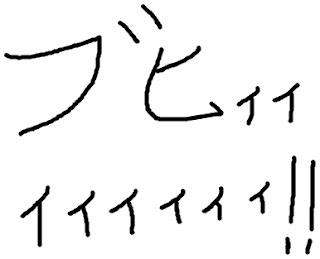Previously, I began dividing characters into four categories of character "age," of which I introduced the "senior citizen" (part 69) and "baby" (part 70). Remaining are the "youth" and "elder" characters, which are positioned between the "baby" and "senior citizen."
The "youth" uses so-called "youth slang," for example kimokawa(1) (creepy-cute) and panee in place of hanpa de naku (sugoi) (incredible)(2). Actual young people might say: "Kimokawa and panee are already outdated. The new hotness is…." Or they might say "I don't understand youth slang. I don't speak it either." There are various types of youth, but the idealized "youth" character speaks in youth slang.
However, if we turn to more grammatical matters, such as auxiliary verbs and interjectory particles, we find that modes of speech that are specific to "youths" are fewer than expected. For example, the returned rising final intonation of the interjectory particle yo-o (part 67) in bengoshi ga yo-o, zaisan wo yo-o… (the lawyer [did something about] the assets…), cannot be said to be a "youth" mode of speech.
It has always been merely a "vulgar" mode of speech. An "elder" of low class would use it, while a "youth" of high class wouldn't.
However, we can see characteristically "youthful" phenomena in pronunciation. One is the style of saying an entire negative-form adjective with a rising intonation. For example, in seeking for another's agreement, a youth would say kore, karakunai? (isn't this spicy?), using the negative form (karakunai) of the adjective (karai), and pronouncing the entire word with a rising intonation. In other words ka would be said with the lowest intonation, ra a bit higher, ku even higher, na higher still, and i with the highest intonation. This has been denigrated as the abrasive speech style of "youths," but it is not exactly an innovation. For example, when inviting someone to go somewhere, i.e. seeking their consent, one might use a verb in its negative form and give the entire word a rising intonation —ikanai? or ikimasen? (won't you go [with me]?). This mode of speech has been around for a long time, and now it has simply been applied to adjectives.
Looking only at "female" "youth" characters, i.e. "young ladies," we can further observe unique pronunciations. "Young ladies" are the only characters who, upon seeing a small animal or child, will affect nasal speech Iyu-n, kuwayuii (i.e. Iya-n, kawaii -Aah! How cute!) while writhing ecstatically. What on earth is this? If they were imitating the "baby" style in an attempt to sound cute, I'd understand, but even "babies" don't talk like this. Perhaps they are carrying the cuteness of the "baby" style to its logical conclusion, or maybe it is something completely different.
Between the "senior citizen" and "youth" is the "elder." The "elder" may use so-called "middle-aged expressions" like doron suru (sneak away), but it is very hard to find any mode of speech, either in terms of grammar or intonation, that is peculiar to the "elder." Their use of arrogant or obsequious speech is, ultimately, the speech of "superiors" or "inferiors," and is therefore linked to "status" not "age."
In the age groups that fall between the "senior citizen" and "baby," the perspectives of "class," "status" and "gender" probably have more significance than "age."
I already spoke at some length on "class," "status," "gender," and "age" (part 57–). I tried to be as comprehensible as possible, but I am sure my readers have various questions for me. I would like to proceed by anticipating then responding to some of these questions, and thereby supplement my explanation of the forms of verbal characters as I see them.
* * *
(1) Contraction of kimochi warui (creepy/unsettling) and kawaii (cute).
(2) Hanpa by itself means "half," but is often seen paired with the negative –"hanpa ja nai" or "hanpa de naku"– not by "half" or in other words, "very much/incredibly." Panee is apparently a contraction of the last syllable of hanpa and the last part of the casual form of the negative auxiliary verb -ja nee.
An Unofficial Guide for Japanese Characters 73 >>





